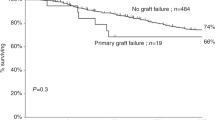Abstract
BMT was carried out on a patient with DiGeorge syndrome who suffered recurrent infections after birth. At 13 months of age, 8.0 × 108/kg of bone marrow nuclear cells were infused from an HLA-identical sibling using only anti-thymocyte globulin to prevent rejection. Donor DNA was not detected on microsatellite polymorphism by PCR. At 19 months of age, a second BMT from the same donor was carried out using busulfan and cyclophosphamide as conditioning. DNA examination of bone marrow showed chimerism at day 18 and complete donor origin at day 28. Seven months post-BMT, the numbers of CD3-, CD4- and CD8-positive cells were in the normal range. BMT is thus an effective therapy for DiGeorge syndrome.
This is a preview of subscription content, access via your institution
Access options
Subscribe to this journal
Receive 12 print issues and online access
$259.00 per year
only $21.58 per issue
Buy this article
- Purchase on Springer Link
- Instant access to full article PDF
Prices may be subject to local taxes which are calculated during checkout
Similar content being viewed by others
Author information
Authors and Affiliations
Rights and permissions
About this article
Cite this article
Matsumoto, T., Amamoto, N., Kondoh, T. et al. Complete-type DiGeorge syndrome treated by bone marrow transplantation. Bone Marrow Transplant 22, 927–930 (1998). https://doi.org/10.1038/sj.bmt.1701475
Received:
Accepted:
Published:
Issue Date:
DOI: https://doi.org/10.1038/sj.bmt.1701475
Keywords
This article is cited by
-
Immunologic reconstitution in 22q deletion (DiGeorge) syndrome
Immunologic Research (2009)
-
Esophageal atresia and tracheo-esophageal fistula associated with coarctation of the aorta, CHARGE association, and DiGeorge syndrome: a case report and literature review
Pediatric Surgery International (2008)
-
FISH investigation of 22q11.2 deletion in patients with immunodeficiency and/or cardiac abnormalities
Pediatric Surgery International (2006)
-
Post-Natal Ontogenesis of the T-Cell Receptor CD4 and CD8 Vβ Repertoire and Immune Function in Children with DiGeorge Syndrome
Journal of Clinical Immunology (2005)



